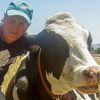
In the depressing and sad wake of the recent ghastly tragedy in Newtown, Connecticut, the details of which are easily available and too horrific to repeat here, a number of people have asked me, "What can we learn about human violence from nonhuman animals?" Given recent acts of heinous human violence in addition to the ongoing wars in which we're engaged, it's worth revisiting what we know about the social behavior of nonhuman animals (animals) and also pointing out some new information from the results of recent detailed scientific research. In a nutshell, we shouldn't be blaming other animals for our violent and evil ways and we truly are "born to be good."
When discussing violent behavior in humans, newscasters and other people quite often refer to those who commit these acts as "animals" or say they're "acting like animals." However, this dismissal is based on a lack of knowledge about the latest scientific research on animals that clearly shows that individuals of many species are far more cooperative, peaceful, kind, compassionate, empathic and nicer than previously thought. However, regardless of mounting scientific evidence that nonhumans are predominantly cooperative, peaceful and fair, and on occasion display social justice (see also and also), media hype often portrays other animals as being far more violent and war-like than they really are.
Cruelty, violence and warlike behaviors in other animals are extremely rare
An important essay by columnist John Horgan that was published in 2010 in Scientific American summarizes much of what is known about warfare in great apes and other primates. Horgan is especially concerned with what is called the "demonic male" theory that states,
both male humans and chimpanzees, our closest genetic relatives, are 'natural warriors' with an innate predisposition toward 'coalitionary killing,' which dates back to our common ancestor." Horgan summarizes what is actually known as follows: "All told, since Jane Goodall began observing chimpanzees in Tanzania's Gombe National Park in 1960, researchers have directly observed 31 intergroup killings, of which 17 were infants... researchers at a typical site directly observe one killing every seven years... my criticism -- and that of other critics I've cited -- stems from science, not ideology. The evidence for the demonic-males theory, far from extraordinary, is flimsy.
Consider also what world renowned primatologist Jane Goodall wrote about violence in wild chimpanzees in her landmark book The Chimpanzees of Gombe:
it is easy to get the impression that chimpanzees are more aggressive than they really are. In actuality, peaceful interactions are far more frequent than aggressive ones; mild threatening gestures are more common than vigorous ones; threats per se occur much more often than fights; and serious, wounding fights are very rare compared to brief, relatively mild ones. (p. 357)
And, along these lines, Robert W. Sussman, an anthropologist at Washington University in St. Louis, and his colleagues Paul A. Garber and Jim Cheverud, reported in 2005 in The American Journal of Physical Anthropology that for many nonhuman primates, more than 90 percent of their social interactions are affiliative rather than competitive or divisive (see also this book and this essay for an update on what we're learning about cooperation in other animals).
Positive emotions lie at the core of human nature just as they do for other animals: We're born to be good
We're also learning a lot about moral behavior in very young children. For example, researchers who study child's play, like Ernst Fehr, of the University of Zurich, and Anthony D. Pellegrini, of the University of Minnesota, have discovered that basic rules of fairness guide play, and that egalitarian instincts emerge very early in childhood. Indeed, while playing, children learn, as do other young animals, that there are right and wrong ways to play, and that transgressions of fairness have social consequences, like being ostracized. Research has also shown that six-month-old babies know right from wrong. And, of course, there's University of California psychologist Dacher Keltner's wonderful book called Born To Be Good in which he shows that positive emotions lie at the core of human nature just as they do for other animals.
In my own interests in how we can rewild our hearts and better and more closely connect with other nature I argue that rewilding is all about being nice, kind, compassionate, empathic, and harnessing our inborn goodness and optimism. As I noted in an interview with the Huffington Post, there's so much new research showing that across cultures humans are really much nicer than we ever give them credit for. It's that relatively few who wage wars, kill people, harm children, and they get in the news. However, probably 99.9 percent of the people in the world are nice, kind, generous, and beneficent, and that's what we're discovering in nonhuman animals. I've been teaching a course on animal behavior and conservation at the Boulder County Jail for more than 12 years and when an inmate says to another prisoner, "You're acting like an animal," I always say, "You just complimented him!" and this leads to fruitful discussions about what we know about the social behavior of other animals and who we really are.
So, do animals fight with one another? Yes they do. Do they routinely engage in cruel, violent, warlike behaviors? Not at all; they're extremely rare compared to other patterns of social behavior. Thus, we can learn a lot about who we really are from paying attention to what we are learning about the social behavior of other animals, and harness our own innate goodness to make the world a better place for all beings.
We need to develop a science of peace and build a culture of empathy
An excellent book titled War, Peace, and Human Nature: The Convergence of Evolutionary and Cultural Views edited by Douglas Fry that deals with many of these issues will be published in early 2013. In this book ethologist Peter Verbeek notes,
we go to war not because we are naturally driven to do so, but because we choose to do so. A choice for war is linked to overcoming fear and empathy, and it is critically important to understand what biological. social-learning, and cultural factors take us there.
We all must work together for a science of peace and build a culture of empathy, and emphasize the positive and pro-social (voluntary behavior to benefit another) side of our and other animals' character. It's truly who we and other animals are and it's about time we focus on the good side of human and animal nature. As renowned primatologist Frans de Waal notes, nature offers many lessons for a kinder society. There really is hope if we pay attention to what we know and push aside misleading sensationalist media that misrepresents us and other animals.
